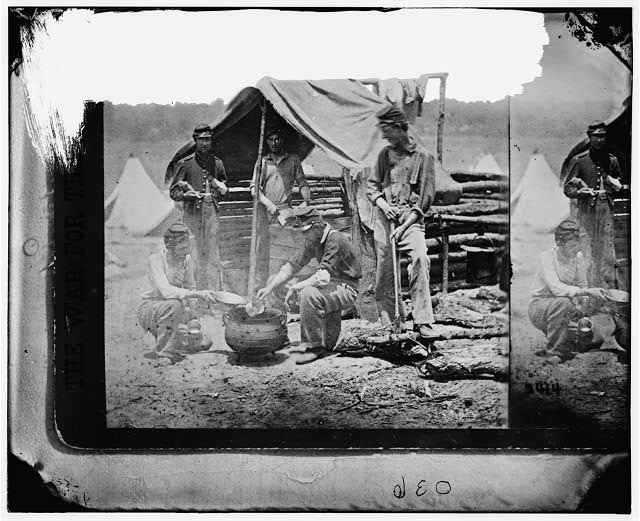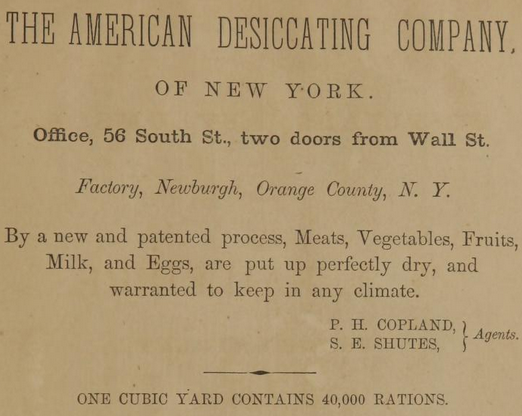This Preparation of Husks: Desiccated Vegetables and the Union Army
Today we are pleased to welcome back guest author James Brookes.

Federal soldiers often mused over the origins of the rations issued to them. One supplement, “furnished in lieu of potatoes, rice and peas or beans”, particularly perplexed them.[i] It came dried in cakes, blocks and sheets, swelled to an astounding size when boiled, and gave a dubious impression that led to curiosity towards its contents. Few enjoyed the substitute, many despised it. The unpopular ration was a reflection of the modernisation of warfare and the attempts by the Union Army to ensure the enlisted man’s preservation of health in an extensive, efficient, and inexpensive manner.
In 1852 the U.S. Navy’s Bureau of Provisions and Clothing reported a newspaper notice announcing an important discovery exhibited by Peyrusset, Moller & Co., of Paris at the 1851 meeting of the Horticultural Society in London. The exhibit involved “various dried vegetables, such as peas, haricot beans, Brussels sprouts, carrots, turnips,” that had been dried by a process consisting of dividing the vegetables “into pieces, placing them in an apparatus into which dried air is driven, until they have parted with all the water, and have become perfectly dry.”[ii] The Navy shortly conducted various experiments on these desiccated vegetables in order to verify their suitability for confronting the issue of scurvy aboard ships.

Officials found desiccated vegetables to be compact, long-lasting and portable. The army introduced them in 1857.[iii] In 1861 Randolph B. Marcy, a U.S. Army captain, claimed that they were “almost equal to the fresh” and praised the product for its antiscorbutic properties. The ration would keep for years if not exposed to dampness, and “A small piece… about half of the size of a man’s hand, when boiled, swells up so as to fill a vegetable dish.” Marcy claimed that a cubic yard contained 16,000 rations.[iv] The American Desiccating Company of New York advertised that its desiccated vegetable soup cost 25 cents per pound and that a cubic yard contained 40,000 rations.[v]
Despite Marcy’s claim others doubted the dried vegetable’s ability to provide a similar nutrition value to that of fresh produce. In 1858 a scurvy epidemic struck at Fort Laramie in Kansas Territory and Assistant Surgeon Edward W. Johns identified the main cause as the fact the soldiers were subsisting on desiccated vegetables. He believed that components of fresh vegetables were lost during the process. The Commissary Department replied that scurvy could not be a problem because the supply of desiccated vegetables was liberal.[vi] Even as late as 1919, Philip B. Hawk of the Jefferson Medical College in Philadelphia commented on the need for “comprehensive studies” to scientifically assure that “desiccated vegetables possess[ed] proper nutritive value.”[vii]
Judging by first-hand accounts Federal soldiers loathed the substitute and it was quickly termed “desecrated” vegetables. John D. Billings described them as “sanitary fodder for the soldiers.” When soaked, “a favourable opportunity was afforded to analyze its composition. It seemed to show… layers of cabbage leaves and turnip tops” with “sliced carrots, turnips, parsnips, a bare suggestion of onions… with a large residuum of insoluble and insolvable material which appeared to play the part of warp to the fabric”. An inspector found one issue with powdered glass thickly sprinkled through it, supposedly the work of a Confederate emissary.[viii] E. N. Gilpin of the 3rd Iowa Cavalry wrote of the trials involved in cooking with desiccated vegetables: “We have boiled, baked, fried, stewed, pickled, sweetened, salted it, and tried it in puddings, cakes and pies; but it sets all modes of cooking at defiance, so they boys break it up and smoke it in their pipes!”[ix]
There were also those who seemed surprisingly fond of the dubious ration. Major Abner R. Small of the 16th Maine Volunteers observed that when cooked this “substitute for food” reminded him of “a dirty brook with all the dead leaves floating around promiscuously”, but noted that “We ate it, and we liked it, too.”[x] Alfred Bellard of the 5th New Jersey also seemed content with this lot: “desacated vegetables were all kinds of green stuf pressed into a square cake… it would swell out and make a very nice soup.”[xi] Soldiers suffered nutritional deficiencies as a result of consuming army rations, especially when on the march when their fare was further limited. It is likely that these men were merely glad to have, in at least some form, vegetables and the benefits they provided.
The ration certainly affected a change in the men. Charles E. Davis, Jr. of the 13th Massachusetts Volunteers wrote: “It was at Darnestown that we were first made acquainted with… ‘desiccated’ vegetables… it tasted like herb tea. From the flow of language that followed, we suspected it contained powerful stimulating properties.” One might assume that this claim about energised, conversational soldiers is in reference to the supplement of vitamins received by the soldiers through consuming the desiccated vegetables. However, Davis was quick to note that this “abominable compound” sparked remarks amongst that men that may have urged its discontinuance as a ration “inasmuch as we rarely, if ever, had it again.”[xii]
Typically, officials continued to insist upon the benefits and advantages of the dried, compact substitute for fresh vegetables. This is certainly understandable, especially considering the debilitating implications of outbreaks of scurvy and the difficulties in procuring fresh produce for the soldiers. The scientist Eben N. Horsford stated that the ration was “serviceable in arresting tendencies to scorbutic disease, and in promoting and preserving the general health.” On the contrary, fresh vegetables were liable to “spontaneous decay” and this rendered their use “quite out of the question.”[xiii] J. Britt McCarley, the former assistant command historian and archivist in the U.S. Army Quartermaster Center has observed that a better solution to the problem was to “issue dry-storable vegetables such as potatoes and onions, or processed foods such as pickles and sauerkraut.” Unfortunately, those remedies were not always available and the men had to endure their “baled hay” when it came.[xiv]
The dried vegetable compound was seemingly unpopular amongst enlisted men and officers, but it reflected the Union Army’s attempt to utilise what it deemed an advanced method of supplying nutrition efficiently to the soldiers. Billings deemed it more suitable for “Southern swine than Northern soldiers”, but the supply of fresh vegetables often led to wasted funds and food loss from decomposition.[xv] Though detested, desiccated vegetables provided a transportable and long-life substitute source for nutrition and vitamins in a conflict in which the U.S. grappled with the great task of mobilising and feeding over 2 million citizen-soldiers.
[i] Eben N. Horsford, The Army Ration: How to Diminish its Weight and Bulk, Secure Economy in its Administration, Avoid Waste, and Increase the Comfort, Efficiency, and Mobility of the Troops, (New York: D. Van Nostrand, 1864), p. 11
[ii] ‘Navy Department, Bureau of Provisions and Clothing, July, 1852.’, in Desiccated Alimentary Vegetable Substances : Reports of Two Boards of Navy Officers, (Washington: C. Alexander, Printer, 1852), p. 3
[iii] Clayton R. Newell, Charles R. Shrader, Of Duty Well and Faithfully Done: A History of the Regular Army in the Civil War, (Lincoln: University of Nebraska Press, 2011), p. 116
[iv] Randolph B. Marcy, The Prairie Traveler: A Handbook for Overland Expeditions, (NY: Harper & Brothers Publishers, 1861)
[v] ‘The American Desiccating Company of New York.’, in Frank Hastings Hamilton, M.D., A Practical Treatise on Military Surgery, (New York: Bailliere Brothers, 1861), p. 237
[vi] Frank R. Freemon, Gangrene and Glory: Medical Care during the American Civil War, (Champaign, Il: University of Illinois Press, 1998)
[vii] Philip B. Hawk, ‘Desiccated Vegetables.’, Science, New Series, Vol. 49, No. 1266 (American Association for the Advancement of Science, Apr. 4, 1919), p. 329
[viii] John D. Billings, Hardtack and Coffee: The Unwritten Story of Army Life, (Boston: George M. Smith & Co., 1887), p. 139
[ix] Quoted in Newell, Shrader, Of Duty Well and Faithfully Done, p. 116
[x] Harold A. Small ed., The Road to Richmond: The Civil War Memoirs of Major Abner R. Small of the 16th Maine Volunteers, p. 197-8, in William C. Davis, A Taste for War: The Culinary History of the Blue and the Gray, (Mechanicsburg, PA: Stackpole Books, 2003), p. 22
[xi] David H. Donald ed., Gone for a Soldier: The Civil War Memoirs of Private Alfred Bellard, (Boston, MA: Little, Brown and Company, 1975), p. 119
[xii] Charles E. Davis, Jr., ‘September 13, 1861.’, Three Years in the Army: The Story of the Thirteenth Massachusetts Volunteers, (Boston, MA: Estes and Lauriat, 1894), p. 13
[xiii] Horsford, The Army Ration, p. 10
[xiv] J. Britt McCarley, Feeding Billy Yank: Union Rations between 1861 and 1865, (Quartermaster Professional Bulletin, December 1988)
[xv] Billings, Hardtack and Coffee, p. 139
3 Responses to This Preparation of Husks: Desiccated Vegetables and the Union Army